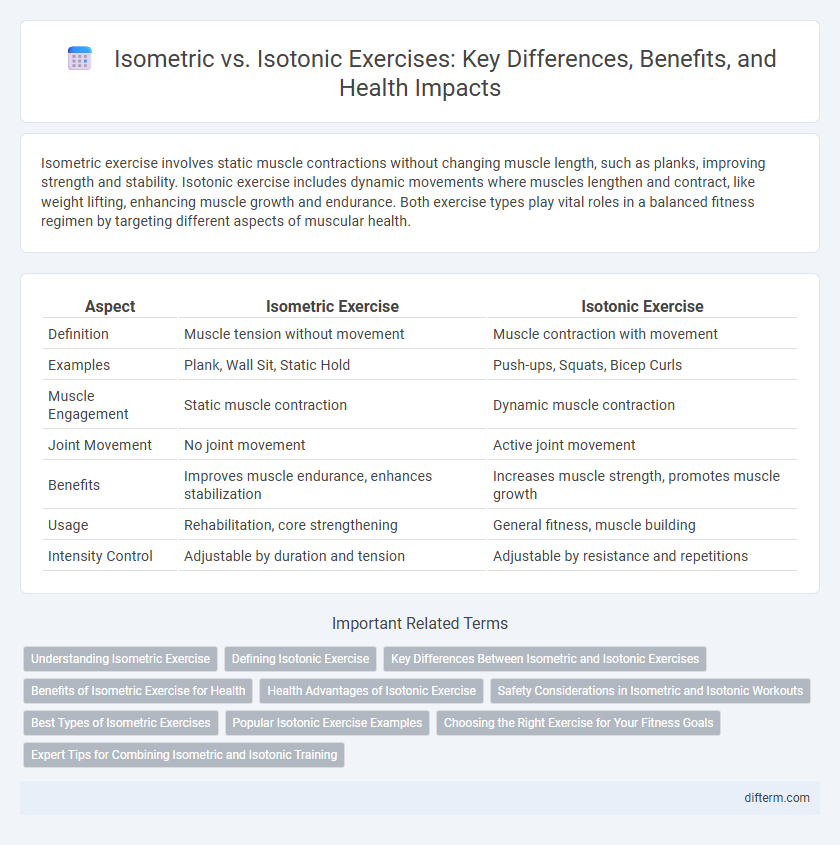Isometric exercise involves static muscle contractions without changing muscle length, such as planks, improving strength and stability. Isotonic exercise includes dynamic movements where muscles lengthen and contract, like weight lifting, enhancing muscle growth and endurance. Both exercise types play vital roles in a balanced fitness regimen by targeting different aspects of muscular health.
Table of Comparison
| Aspect | Isometric Exercise | Isotonic Exercise |
|---|---|---|
| Definition | Muscle tension without movement | Muscle contraction with movement |
| Examples | Plank, Wall Sit, Static Hold | Push-ups, Squats, Bicep Curls |
| Muscle Engagement | Static muscle contraction | Dynamic muscle contraction |
| Joint Movement | No joint movement | Active joint movement |
| Benefits | Improves muscle endurance, enhances stabilization | Increases muscle strength, promotes muscle growth |
| Usage | Rehabilitation, core strengthening | General fitness, muscle building |
| Intensity Control | Adjustable by duration and tension | Adjustable by resistance and repetitions |
Understanding Isometric Exercise
Isometric exercises involve muscle contractions without joint movement, enhancing strength and stability by maintaining tension in a fixed position. These exercises, such as planks and wall sits, boost muscular endurance and improve posture by activating specific muscle groups intensely. Unlike isotonic exercises, isometric training minimizes joint strain, making it ideal for rehabilitation and injury prevention.
Defining Isotonic Exercise
Isotonic exercise involves muscle contraction with joint movement, typically categorized into concentric and eccentric actions where muscles shorten or lengthen under tension. Common examples include weightlifting and bodyweight exercises like push-ups or squats, which enhance muscle strength and endurance. These dynamic movements promote improved muscular coordination and cardiovascular health by continuously varying muscle length and tension.
Key Differences Between Isometric and Isotonic Exercises
Isometric exercises involve muscle contractions without changing muscle length, enhancing static strength and stability, whereas isotonic exercises involve muscle length changes through concentric and eccentric movements, improving dynamic strength and endurance. Isometric routines, such as planks, maintain constant joint angles, while isotonic workouts like squats and bicep curls engage muscles through a full range of motion. Key differences include the type of muscle action, joint movement, and their specific benefits for strength training and rehabilitation programs.
Benefits of Isometric Exercise for Health
Isometric exercise, characterized by muscle contraction without joint movement, enhances muscle strength and stability while reducing joint stress, making it ideal for injury rehabilitation and elderly fitness. It improves muscular endurance and supports posture by engaging core muscles continuously. This form of exercise also aids in blood pressure regulation and promotes neuromuscular control, contributing to overall cardiovascular health and functional mobility.
Health Advantages of Isotonic Exercise
Isotonic exercise improves cardiovascular health by increasing heart rate and promoting efficient blood circulation throughout the body. It enhances muscle endurance and strength through dynamic movements, contributing to better joint flexibility and overall functional fitness. Regular isotonic workouts reduce the risk of chronic diseases like hypertension and type 2 diabetes by supporting weight management and metabolic health.
Safety Considerations in Isometric and Isotonic Workouts
Isometric exercises, which involve static muscle contractions without joint movement, reduce the risk of joint strain and are ideal for individuals with joint issues or during rehabilitation. In contrast, isotonic exercises, characterized by muscle length changes during movement, enhance overall muscle strength and flexibility but require proper form to prevent injuries such as muscle strains or joint stress. Both exercise types demand attention to proper technique and gradual progression to ensure safety and maximize health benefits.
Best Types of Isometric Exercises
Isometric exercises, such as planks, wall sits, and static lunges, are highly effective for improving muscle strength and endurance without joint movement, making them ideal for rehabilitation and injury prevention. Unlike isotonic exercises that involve dynamic movements, isometric workouts maintain constant muscle tension, enhancing stability and core strength. Incorporating best types of isometric exercises into a fitness routine promotes muscular balance and supports overall functional performance.
Popular Isotonic Exercise Examples
Popular isotonic exercises include activities like squats, push-ups, and pull-ups, where muscles change length during movement, promoting strength and endurance. These exercises enhance joint mobility and cardiovascular health by involving dynamic muscle contractions with consistent resistance. Isotonic exercises are widely recommended for overall fitness improvement and rehabilitation due to their functional benefits and variety.
Choosing the Right Exercise for Your Fitness Goals
Isometric exercise involves muscle contraction without joint movement, ideal for building static strength and improving stability, while isotonic exercise focuses on muscle length changes through dynamic movements to enhance muscular endurance and overall functional fitness. Choosing the right exercise depends on your fitness goals: isometric exercises benefit rehabilitation and core strengthening, whereas isotonic exercises are better for increasing muscle mass and cardiovascular health. Incorporate both types to achieve balanced muscle development and optimize physical performance.
Expert Tips for Combining Isometric and Isotonic Training
Integrating isometric and isotonic exercises enhances muscular strength and endurance by targeting both static and dynamic muscle actions effectively. Experts recommend starting with isometric holds to activate stabilizing muscles before progressing to isotonic movements for functional strength gains. Optimal results come from balancing intensity and duration, ensuring proper form and gradual overload to prevent injury and promote muscle adaptation.
Isometric Exercise vs Isotonic Exercise Infographic

 difterm.com
difterm.com